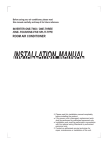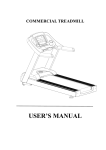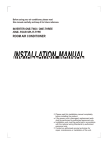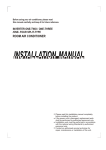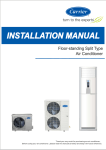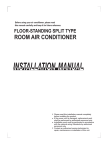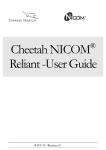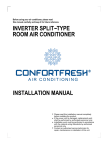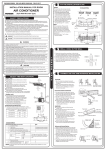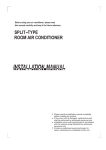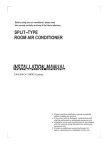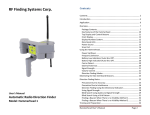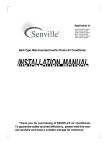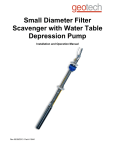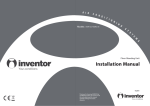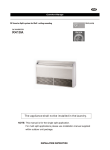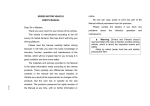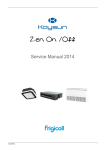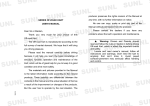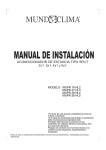Download PAMSCH 12 18 16 INSTALL_p1_p10
Transcript
Before using your air multi-zone conditioner, inverter please mini-split read system, please read this manual carefully and keep it for future reference along with your receipt. INVERTER MULTI-ZONE HEAT PUMP MINI-SPLIT SYSTEMS ROOM AIR CONDITIONER Please read this installation manual completely before installing the product. Replacement and repair work shall be performed by authorized personnel only. Installation work must be performed in accordance with the national wiring standards by authorized personnel only. Contact an authorized service technician for repair, maintenance or installation of this unit. CONTENTS SAFETY PRECAUTIONS Warning ...........................................................................................................................................2 Caution ............................................................................................................................................2 INSTALLATION INSTRUCTIONS Selecting installation place...............................................................................................................3 Wall-mounted type ...........................................................................................................................3 Accessories .........................................................................................................4 Four-way cassette type ....................................................................................................................9 Outdoor unit installation ..........................................................................................................................15 REFRIGERANT PIPE CONNECTION Refrigerant pipe connection .............................................................................................................16 ELECTRICAL WORK Electrical work ................... .............................................................................................................17 AIR PURGING Air purging with vacuum pump .........................................................................................................21 Safety and leakage check ................................................................................................................22 TEST RUNNING Test running ............................................................................................................................................23 TROUBLE SHOOTING TIPS Trouble shooting tips .....................................................................................................................24 Read This Manual This manual provides the information needed for proper use and maintenance of this unit. Basic preventive care can help extend the life of this unit. The “Troubleshooting Tips” contains a chart with solutions to the most common problems. Referring to this section may save time and prevent the need for a service call in the event of a problem. CAUTION Contact an authorized service technician for repair or maintenance of this unit. Contact an authorized installer for installation of this unit. The air conditioner is not intended for use by young children without supervision. Disabled persons may require assistance with set up. Young children should be supervised to ensure that they do not play with the air conditioner. Replacement work shall be performed by authorized personnel only. Installation work must be performed in accordance with the national wiring standards by authorized personnel only. 1 SAFETY PRECAUTIONS Read the following SAFETY PRECAUTIONS carefully before installation. Electrical work must be installed by a licensed electrician. Be sure to use the correct rating of the power plug and main circuit for the model to be installed. Incorrect installation due to ignoring of the instructions will cause harm or damage. The seriousness is classified by the following indications. WARNING CAUTION This symbol indicates the possibility of death or serious injury. This symbol indicates the possibility of injury or damage to property. The items to be followed are classified by the symbols: Symbol with white background denotes item that is PROHIBITED from doing. WARNING 1) Engage dealer or specialist for installation. If installation done by the user is defective, it will cause water leakage, electrical shock or fire. 2) Install according to these installation instructions strictly. If installation is defective, it will cause water leakage, electrical shock or fire. 3) Use the attached accessories parts and specified parts for installation. Otherwise, it will cause the set to fall, water leakage, electrical shock or fire. 4) Install at a strong and firm location which is able to withstand the set ,s weight. If the strength is not enough or installation is not properly done, the set will drop and cause injury. 5) For electrical work, follow the local national wiring standard, regulation and these installation instructions. An independent circuit and single outlet must be used. If electrical circuit capacity is not enough or defect found in electrical work, it will cause electrical shock or fire. 6) Use the specified cable and connect tightly and clamp the cable so that no external force will be acted on the terminal. If connection or fixing is not proper, it will cause heat-up or fire at the connection. 7) Wiring routing must be properly arranged so that control board cover is fixed properly. If control board cover is not fixed properly, it will cause heat-up at connection point of terminal, fire or electrical shock. 8) When carrying out piping connection, take care not to let air substances other than the specified refrigerant go into refrigeration cycle. Otherwise, it will cause lower capacity, abnormal high pressure in the refrigeration cycle, explosion and injury. 9) Do not modify the length of the power supply cord or use of extension cord, and do not share the single outlet with other electrical appliances. Otherwise, it will cause fire or electrical shock. CAUTION 1) This equipment must be grounded and installed with grounding leakage current breaker. It may cause electrical shock if grounding is not proper. 2) Do not install the unit at place where leakage of flammable gas may occur. In case gas leaks and accumulates at surrounding of the unit, it may cause fire. 3) Carry out drainage piping as mentioned in installation instructions. If drainage is not proper, water may enter the room and damage the furniture. 2 INSTALLATION INSTRUCTIONS 1. Wall-mounted type Selecting installation place More than 6in.(15cm) Read completely, then follow step by step. Indoor unit More than 4.73in.( 12cm) More than 4.73in.(12cm) Do not expose the indoor unit to heat or steam. Select a place where there are no obstacles in front or around the unit. Make sure that condensation drainage can More than 6.57ft( 2.0m) be conveniently routed away. Do not install near a doorway. Fig.1 Ensure that the space on the left and right of the unit is more than 5 inches (12cm). Use a stud finder to locate studs to prevent unnecessary damage to the wall. The indoor unit should be installed on the wall at a height of 7 feet (2.0 m) or more from the floor. The indoor unit should be installed allowing a minimum clearance of 6 inches (15cm) from the ceiling. Any variations in pipe length will/may require adjustment to refrigerant charge. There should not be any direct sunlight. Otherwise, the sun will fade the plastic cabinet and affect its appearance. If unavoidable, sunlight prevention should be taken into consideration. Outdoor unit More than 11.9in.( 30cm) If an awning is built over the outdoor unit to prevent direct sunlight or rain exposure, More than 11.9in. (30cm) make sure that heat radiation from the condenser is not restricted. Ensure that the clearance around the back More than 23.7in.( 60cm) of the unit is more than 12 inches (30cm) and left side is more than 12 inches (30cm). The front of the unit should have more than 7 feet (2m) of clearance and the More than 6.57ft( 200cm) connection side (right side) should have more Fig.2 than 24 inches (60cm) of clearance. Do not place animals and plants in the path of the air inlet or outlet. Take the air conditioner weight into account and select a place where noise and vibration will not be an issue. Select a place so that the warm air and noise from the air conditioner do not disturb neighbors. Rooftop installation: If the outdoor unit is installed on a roof structure, be sure to level the unit. Ensure the roof structure and anchoring method are adequate for the unit location. Consult local codes regarding rooftop mounting. If the outdoor unit is installed on roof structures or external walls, this may result in excessive noise and vibration, and may also be classed as a non serviceable installation. 3 INSTALLATION INSTRUCTIONS Tools needed for installation: Level gauge Screwdriver Electric drill, Hole core drill (2.5 inches (65mm)) Flaring tool set Specified torque wrenches: 13.0 lb.ft., 30.4 lb.ft., 39.8 lb.ft., 47.7 lb.ft. (different depending on model No.) Spanner (half union) Service wrench Gas-leak detector Vacuum pump Gauge manifold Users manual Thermometer Multimeter Pipe cutter Measuring tape Parts List Number Qty/one unit Name of Part 1 Installation Plate 2 Plastic Expansion Sheath (depending on models) 3 Self-Tapping Screw A ST3.9X25 (depending on models) 4 Connecting Pipe Assembly Liquid side Gas side 1 5-8 5-8 1/4 6.35mm) 3/8 9.53mm 1/2 12.7mm) Parts you must purchase Consult the technician for the proper size. 5 Remote Control 1 6 Self-tapping Screw B ST2.9X10 2 7 Remote Control Holder 1 8 Seal (for cooling& heating models only) 1 9 Drain Joint (for cooling& heating models only) 1 10 Transfer connector ( Packed with the indoor unit ) (NOTE: Pipe size differs from appliance to appliance. To meet different pipe size requirement, sometimes the pipe connections need the transfer connector to install on the outdoor unit .) 4 1 (on some models) INSTALLATION INSTRUCTIONS Mor e th a n 4 . 73 in . ( 1 2cm More than 4 . 7 3 i n .(1 2c 2 m) More than 6in.(15cm) 1 More 4 .7 3 in th a n .( 1 2 c m) ) 3 M or e th an 4.73in.(1 2c Remote control Air filter Air filter Air filter 4 5 Remote Remote control control Remote control Mo 4in re tha .(10 n cm ) More than 23.7in.( 60cm) ter Air fil m) 6 n ) tha 0cm re 3 Mo 9in.( . 11 Air out A Mo 2 3 r e th .7i n.( an 60 cm an ) th .0m re t( 2 Mo 57f B 6. One-Two Zone One-Three Zone One-Four Zone C ) Loop a connective cable Fig.3 CAUTIONS This illustration is for explanation purposes only. The actual shape of your air condtioner may be slightly different. Copper lines must be insulated independently. CAUTION Use a stud finder to locate studs to prevent unnecessary damage to the wall. A minimum pipe run of 10ft (3m) is required to minimize vibration & excessive noise. Two of the A, B and C directions should be free from obstructions. 5 INSTALLATION INSTRUCTIONS Indoor unit installation (wall-mounted type) Correct orientation of Installation Plate 1. Fit the Installation Plate 1. Fit the installation plate horizontally on structural parts of the wall with spaces around the installation plate. 2. If the wall is made of brick, concrete or the like, drill five or eight 0.197 inches ( 5mm) diameter holes in the wall. Insert Clip anchor for appropriate mounting screws. 3. Fit the installation plate on the wall with five or eight type “A” screws. 6in.(150mm) or more to ceiling C Indoor unit outline D Installation plate 4.8in.(120mm) or more to wall B 4.8in.(120mm) or more to wall Right rear side refrigerant pipe hole 2.6in. 1.8 1.8 Left rear side refrigerant pipe hole 2.6 A Model A (A: 28, B: 9.84, C:3.94, D: 4.33) Model B( A: 31.1, B:10.43, C:3.94, D: 5.9 ) 6in.(150mm) or more to ceiling 4.8in.(120mm) or more to wall 4.8in.(120mm) or more to wall Right rear side refrigerant pipe hole 2.6in. 1.8 Left rear side refrigerant pipe hole 2.6in. 1.8 Note: Fit the Installation Plate and drill holes in the wall according to the wall structure and corresponding mounting points on the installation plate. The Installation Plate may be slightly different according to the different models of indoor unit. (Dimensions are in “inch” unless otherwise stated) Fig.4 Model A (A: 28, B: 9.84, C: 3.94, D: 4.33) Model B( A: 31.1, B:10.8, C:3.94, D: 3.35 ) Model C( A: 33.5, B:11.4, C:3.94, D: 4.53 ) 6in.(150mm) or more to ceiling Indoor unit outline 5.91in. Installation plate 7.28in. 4.8in.(120mm) or more to wall 2. Drill a hole in the wall 36.14in. Right rear side refrigerant pipe hole 2.6in. Model A (A: 36.2, B: 11.5, C:5.9, D: 7.3) Model B( A: 39.2, B:11.5, C:5.9, D:7.9 ) Model C( A: 33.5, B:12, C:5.9, D:5.7 ) Fig.5 Wall Outdoor Indoor 0.2-0.3in. (5-7mm ) 1. Determine hole positions according to the diagram detailed in Fig.5. Drill one (1) hole (2.5 inches (65mm)) slanting slightly to outdoor side. 1.8 Left rear side refrigerant pipe hole 2.6 1.8 11.5in. 4.8in.(120mm) or more to wall 3. Connective Pipe and Drainage Installation Fig.6 Drainage 1. Run the drain hose sloping downward. Do not install the drain hose as illustrated in Fig.7. Do not block water flow by a rise. Do not put the end of drain hose into water. Fig.7 6 INSTALLATION INSTRUCTIONS 2. When connecting extension drain hose, insulate the connecting part of extension drain hose with a shield pipe, do not let the drain hose slack. Connective pipe installation Fig.8 1. For the left-hand and right-hand piping, remove the pipe cover from the side panel. 2. For the rear-right-hand and rear-left-hand piping, install the piping as shown in Fig.10. Rear-right piping Right-hand piping 3. Fix the end of the connective pipe. (Refer to Tightening Connection in REFRIGERANT PIPING CONNECTION) Rear-left piping Left-hand piping Fig.9 Fig.10 4. Piping and wrapping Bundle the tubing, connecting cable, and drain hose with tape securely, evenly as shown in Fig.11. Because the condensed water from rear of the indoor unit is gathered in evaporative drain pain box and is piped out of room do not put anything else in the box. CAUTION Connect the indoor unit first, then the outdoor unit. Do not allow the piping to let out from the back of the indoor unit. Be careful not to let the drain hose slack. Heat insulated both of the auxiliary piping. Be sure that the drain hose is located at the lowest side of the bundle. Locating at the upper side can cause drain pan to overflow inside the unit. Never intercross nor intertwist the power wire with any other wiring. Run the drain hose sloped downward to drain out the condensed water smoothly. Indoor unit Connective cable Ponding box Pipe room Connective pipe Wrapping belt Drain hose Fig.11 7 INSTALLATION INSTRUCTIONS 4. Indoor unit installation 1. Pass the piping through the hole in the wall. 2. Put the upper claw at the back of the indoor unit on the upper hook of the installation plate, move the indoor unit from side to side to see that it is securely hooked (see Fig.12). 3. Piping can easily be made by lifting the indoor unit with a cushioning material between the indoor unit and the wall. Remove after finished piping. 4. Push the lower part of the indoor unit up on the wall, then move the indoor unit from side to side, up and down to check if it is hooked securely. Fig.12 1 - 4 units 10.5KW 2 Zone Max. Length for all rooms Max. Length for one indoor unit Max. height different between OU higher than IU indoor and outdoor unit OU lower than IU Max. height different between indoor units 8 3 Zone 4 Zone 98 feet 148 feet 197 feet 66 feet 82 feet 98 feet 33 feet 33 feet 33 feet 49 feet 49 feet 49 feet 33 feet 33 feet 33 feet INSTALLATION INSTRUCTIONS 2. Four-way cassette type Attached fittings Please check whether the following fittings are of full scope. If there are some attached fittings free from use, please restore them carefully. (on some models) 1.Installation manual.................................1 2.Owner's manual.....................................1 3. Remote Control................................1 (on some models) 5.Outlet pipe sheath ..............................1 6.Outlet pipe Clasp ...... .............................1 7.Drain joint .............................................1 8. Installation paper board.....................1 11. Expansible hook..............................4 12. Installation hook..............................4 13. Orifice.............................................1 4. Alkaline dry batteries (AM4)............2 9. Soundproof / insulation sheath.........1 14. Frame.............................................1 10. Seal ring..........................................1 15. Mounting screw (ST2.9 10-C-H) ...2 A 11 in. Inlet Ground Fig.13 >39.4in. >39.4in. 21.5 in. 25.5in. Fig.15 22.5in. 25.5in. 20.7in. Fig.14 22.5in 9 Outlet >90.6in. Outlet >39.4in. Indoor unit installation 1. Install the main body A. The existing ceiling (to be horizontal) a. Please cut a square hole of 24 x 24 inches. in the ceiling according to the shape of the installation paper board. (Refer to Fig.15 & 16) The center of the hole should be at the same position of that of the air conditioner body. Determine the lengths and outlets of the connecting pipe, drain pipe and cables. To balance the ceiling and to avoid vibration, please enforce the ceiling when necessary. b. Please select the position of installation hooks according to the hook holes on the installation board. Drill four holes of 0.5 inches (12mm), 2.5 inches (50~55mm) deep at the selected positions on the ceiling. Then embed the expansible hooks (fittings). Face the concave side of the installation hooks toward the expansible hooks. Determine the length of the installation hooks from the height of ceiling, then cut off the unnecessary part. If the ceiling is extremely high, please determine the length of the installation hook according to facts. Necessary room >39.4in. Notes before installation 1. Decide the correct carry-in path. 2. Move this unit as originally packaged as possible. 3. If the air conditioner is installed on a metal part of the building, it must be electrically insulated according to the relevant electrical code. 4. If installing phase protectors at a high position where it is hot and humid with frequent thunderstorms, lightning-protection equipment is necessary. INSTALLATION INSTRUCTIONS The length could be calculated from Fig.17: Length = 8.3 inches + L (in general, L is half of the whole length of the installation hook) c. Please adjust the hexangular nuts on the four installation hooks evenly, to ensure the balance of the body. Properly level the unit to check the level of the main body from the four sides or diagonal line direction, the level indicator also can check the level from four sides of the main body. (Refer to Fig.18) If the drainpipe is not level, leakage will be caused by the malfunction of the water-level switch. Adjust the position to ensure the gaps between the body and the four sides of ceiling are even. The body's lower part should recess into the ceiling for 3/8 inches (10~12mm) (Refer to Fig.17). A Hook 11.2in. Body Nut Ceiling Fig. 16 2. Install The Panel CAUTIONS (1) Remove the inlet grid. Colourless trans parent pipe Fig. 17 Horizontal indicator Fig.18 Fig.19 Central hole Body Hook hole Fixing hole Installation paper board a. Slide two grid switches toward the middle at the same time, and then pull them up. (Refer to Fig.21) b. Draw the grid up to an angle of about 30o, and remove it. (Refer to Fig.22) Installation paper board Screw M5 16 (Accessory) Fig.20 Grid switch Fig.21 o 45 Fig.22 10 6.9in. 0.4~0.46in. L H(ceiling height) 34 Body Ceiling New built houses and ceilings a. In the case of new built house, the hook can be embedded in advance (refer to the A.b mentioned above). But it should be strong enough to bear the indoor unit and will not become loose because of concrete shrinking. b. Refer to the A.c mentioned above for installation. c. Remove the installation template. Panel 23in. INSTALLATION INSTRUCTIONS (2) Install the panel a. Align the swing motor on the panel to the water receiver of the body properly. (Refer to Fig.23) b. Hang the four fixed ropes of the main body to the installation cover and the other three covers of the swing motor: (Refer to Fig.23 ) Drain side Drain side 1 Steel rope 2 CAUTIONS: 33 The installation cover of the swing motor must sink 4 Cover into the corresponding water receiver. Please operate according to the direction of the arrow, c. Install the panel on the main body with bolt (M5 16) or it cannot be disassembled and washer. (Refer to Fig.23) when it is necessary. Fig.23 d. Adjust the four panel hook screws to keep the panel horizontal, and screw them up to the ceiling evenly. Body e. Regulate the panel in the direction of the arrow in Ceiling Panel foam 2 Fig.11 slightly to fit the panel's center to the center of the ceiling's opening. Confirm that hooks of four corners are fixed well. f. Keep fastening the screws under the panel hooks, Panel foam until the thickness of the sponge between the body Outlet air Air plate and the panel's outlet has been reduced to about 0.16~0.24 inches (4~6mm). The edge of the panel should contact Fig.24 with the ceiling well. (Refer to Fig.24) Do not over tighten the screw. (Fig.25) If the gap between the panel and ceiling still exists after fastening the screws, the height of the indoor unit should be modified again. You can modify the height of the indoor unit through the openings on the panel's four corners, if the lift of Ceiling Leakage the indoor unit and the drainpipe is not influenced (refer to Fig.26-right). (3) Hang the air-in grid to the panel, then connect the lead terminator of the swing motor and that of the control box with corresponding terminators on the body respectively. (4) Relocate the air-in grid in the procedure of reversed order, install the air-in grid. Swing motor installation cover Bolt, washer Swing motor side Inlet air Dew Fig.25 Hexagon nut Horizontal adjustment (3) The installation of ventilation motor and ventilation pipe (if necessary) a. Using a tool to knock off the pre-punching hole. (Refer to Fig.27) b. Four screw hole reserved for installation. (Refer to Fig.27 ) Ceiling Fig.26 Four screw hole Pre-punching hole Fig.27 11 Panel sealing foam Panel Panel foam1 INSTALLATION INSTRUCTIONS (4) Water-pump drainage The maximum lifting height is 29.5 inches. 39.4-59.1in. 29.5in. 7.9in. Fig.28 3. Drainage pipe installation (1) Installation principle Ensure at least 1/100 slope of the drainage pipe. Adopt suitable pipe diameter. Adopt nearby condensate water discharge. Before installing condensate water pipeline, determine its route and elevation to avoid intersection with other pipelines and ensure slope is straight. Support drain link per code. (2) Drainage pipe selection The drainage pipe diameter shall not be smaller than the drain hose of indoor unit. According to the water flowrate and drainage pipe slope to choose the suitable pipe, the water flowrate is decided by the capacity of indoor unit. Capacity(x1000Btu) 12 18 24 30 36 42 48 60 Water flowrate(g/h) 2.4 4 6 7 8 10 12 14 12 INSTALLATION INSTRUCTIONS For horizontal drainage pipe (The following table is for reference) Attention: Use DWV/PVC40 or bigger pipe to be the main pipe according to code. The horizontal pipe layout should avoid converse flow or bad flow: Drainage pipe Drainage pipe Water flow Water flow Water flow Drainage pipe Water flow Drain tee Drain tee Water flow Water flow Water flow Water flow Water flow Branch pipe Water flow Drain tee Gas Gas Water flow Keep a certain degree Main pipe Main pipe Branch pipe Fig.30 13 INSTALLATION INSTRUCTIONS (3) Water storage pipe setting If the indoor unit has high extra static pressure and without water pump to elevate the condensate water, such as high extra static pressure duct unit, the water storage pipe should be set to avoid converse flow or blow water phenomena. Indoor unit More than 1.97in.(50mm) Plug More than 0.98in.(25mm) Water storage pipe Fig.31 (4) Lifting pipe setting of indoor unit with water pump The length of lifting pipe should not exceed the pump head of indoor unit water pump. Pump head of big four way cassette: 29.5 inches (750mm). Pump head of compact four way cassette: 19.7 inches (500mm) (9k, 12k, 18k units). The drainage pipe should be set down inclined after the lifting pipe immediately to avoid wrong operation of water level switch. Refer to the following picture for installation reference. Hanger Down incline pipe A A:Length of vertical pipe 5.9in. (150mm) the pump head of water pump B: Lift height B Flexible pipe 11.8in. (300mm) Fig.32 (5) Ventline setting For the concentrated drainage pipe system, there should design a blowhole at the highest point of main pipe to ensure the condensate water discharge smoothly. The air outlet shall face down to prevent dirt entering pipe. Each indoor system should be installed with it. The installation should consider the convenience for future cleaning. Ventline Indoor unit Indoor unit Plug Plug Fig.33 14 INSTALLATION INSTRUCTIONS Outdoor unit installation Outdoor installation precaution Install the outdoor unit on a rigid base to prevent increasing noise level and vibration. Determine the air outlet direction where the discharged air is not blocked. In the case that the installation place is exposed to strong wind such as a seaside, make sure the fan is operating properly by putting the unit lengthwise along the wall or using dust or shield plates. In windy area, install the unit to prevent the admission of wind. If need suspending installation, the installation bracket should accord with technique requirement in the installation bracket diagram. The installation wall should be solid brick, concrete or the same intensity construction, or actions to reinforce, damping supporting should be taken. The connection between bracket and wall, bracket and the air conditioner should be firm, stable and reliable. Be sure there is no obstacle which block radiating air. Strong wind Fig.51 Settlement of outdoor unit Anchor the outdoor unit with a bolt and nut 0.4 inches or 0.3 inches tightly and horizontally on a concrete or rigid mount. Outdoor unit dimension Mounting dimensions W2 L2 inches/mm(L 1xHxW1) (in./mm) (in./mm) 30x23.3x11.3/ 20.9/ 760x590x285 530 11.5/ 290 33.3x27.6x12.6/ 22.1/ 13.2/ 845x700x320 560 335 35.3x33.9x12.5/ 900x860x315 23.3/ 590 13.1/ 333 39x38x13.6/ 990x965x345 24.6/ 624 14.4 366 Fig.52 15 REFRIGERANT PIPE CONNECTION Drain joint installation NOTE: The drain joint differs from appliance to appliance. Fit the seal into the drain joint, then insert the drain joint into the base pan hole of outdoor unit, rotate 90 to securely assemble them. Connecting the drain joint with an extension drain hose (locally purchased), in case of the water draining off the outdoor unit during the heating mode. Base pan hole of outdoor unit Drain joint Seal Seal Drain pipe (2) (1) Refrigerant pipe connection Fig.53 1. Flaring work Main cause for refrigerant leakage is due to defect in the flaring work. Carry out correct flaring work using the following procedure: A: Cut the pipes and the cable. 1. Use the piping kit accessory or pipes purchased locally. 2. Measure the distance between the indoor and the outdoor unit. 3. Cut the pipes a little longer than the measured distance. 4. Cut the cable 59.1 inches (1.5m) longer than the pipe length. 90 Fig.54 Pipe Reamer Point down Fig.55 B: Burr removal 1. Completely remove all burrs from the cut cross section of pipe/tube. 2. Put the end of the copper tube/pipe in a downward direction as you remove burrs in order to avoid dropping burrs into the tubing. Flare nut 1/4 6.35 3/8 (9.53) 1/2 (12.7) Copper tube Fig.56 Bar Handle "A" C: Putting nut on Remove flare nuts attached to indoor and outdoor unit, then put them on pipe/tube having completed burr removal. (Not possible to put them on after flaring work) D: Flaring work Firmly hold copper pipe in a die in the dimension shown in the table below. Outer diam. Inches (mm) Oblique Roughness Bar Yoke A (inches/mm) Max. 0.052/1.3 0.062/1.6 0.071/1.8 Cone Min. 0.03/0.7 0.04/1.0 0.04/1.0 Copper pipe Clamp handle Red arrow mark Fig.57 16 Burr Tightening Connection Align the center of the pipes. Sufficiently tighten the flare nut with fingers, and then tighten it with a spanner and torque wrench as shown in Fig.58 & 59 Outer diam. Indoor unit tubing Flare nut Pipings Fig.58 Tightening Additional tightening torque (lb.ft.) torque (lb.ft.) 1/4 11.1 lb.ft. 11.8 lb.ft. 3/8 18.4 lb.ft. 19.2 lb.ft. 1/2 25.8 lb.ft. 26.5 lb.ft. Caution Excessive torque can break nut depending on installation conditions. Fig.59 Electrical work Electric safety regulations for the initial Installation 1. If there is serious safety problem about the power supply, the technicians should refuse to install the air conditioner and explain to the client until the problem is solved. 2. Power voltage should be in the range of 90%~110% of rated voltage. 3. The creepage protector and main power switch with a 1.5 times capacity of Max. Current of the unit should be installed in power circuit. 4. Ensure the air conditioner is grounded well. 5. According to the attached Electrical Connection Diagram located on the panel of the outdoor unit to connect the wire. 6. All wiring must comply with local and national electrical codes and be installed by qualified and skilled electricians. 7. An individual branch circuit and single receptacle used only for this air conditioner must be available. 17 ELECTRICAL WORK Wiring connection Minimum nominal cross-sectional area of conductors: NOTE: Before performing any electrical work, turn off the main power to the system. Nominal cross-sectional area (mm2) Rated current of appliance (A) CAUTIONS 0.75 >3 and <6 Do not touch the capacitor even if you have disconnected the power for there is still high voltage power on it, or electric shock hazard may occur. For your safety, you should start repairing at least 5 minutes after the power is disconnected. 1 >6 and <10 >10 and <16 1.5 >16 and <25 2.5 Suggest Minimum Wire Size (AWG: American Wire Gage): The power is supplied from the Outdoor Unit. The Indoor Units are connected with signal wires or power cords are connected reliably and correctly, or the air conditioner could not run normally. Appliance Amps AWG Wire Size 10 18 13 16 18 14 25 12 30 10 Screw Cover Connect the cable to the outdoor unit 1. Remove the electrical control board cover from the outdoor unit by loosening the screw as shown in Fig.61 2. Connect the connective cables to the terminals as identified with their respective matched numbers on the terminal block of indoor and outdoor units. 3. Secure the cable onto the control board with the cord clamp. Fig.61 Connection Cable 0.4in. (10mm) 1.6in.(40mm) Fig.62 CAUTIONS Make sure to connect the indoor unit (A, B, C, D) to the Hi and Lo valve and terminals of signal wires (A, B, C, D) of outdoor unit as identified with their respective matched connection. Wrong wiring connections may cause some electrical parts to malfunction. 18 POWER Connective cable of indoor unit and outdoor unit Connective cable of indoor unit and outdoor unit 2 Zone Connective cable of indoor unit and outdoor unit 3 Zone Connective cable of indoor unit and outdoor unit 4 Zone ELECTRICAL WORK NOTE:please refer to the following figures, if the client wants to wire by themselves. Indoor Outdoor One-two models: Model B Model A One-three models: L(A) N(A) S(A) L(B) N(B) S(B) L(C) N(C) S(C) Model B Model A One-four models: L(A) N(A) S(A) L(B) N(B) S(B) L(C) N(C) S(C) L(D) N(D) S(D) Model B Model A Fig.63 19 ELECTRICAL WORK CAUTION CAUTION CAUTION CAUTION Prepare the wiring as follows: 1) Never fail to have an individual power circuit specifically for the air conditioner. As for the method of wiring, be guided by the circuit diagram posted on the inside of control cover. 2) The screws which fasten the wiring in the casing of electrical fittings are liable to come loose from vibrations to which the unit is subjected during the course of transportation. Check them and make sure that they are all tightly fastened. (If they are loose, it could cause burn-out of the wires.) 3) Specification of power source. 4) Confirm that electrical capacity is sufficient. 5) See to it that the starting voltage is maintained at more than 90 percent of the rated voltage marked on the name plate. 6) Confirm that the cable thickness is as specified in the power source specification. 7) Always install a ground leakage circuit breaker in a wet or moist area. 8) The following would be caused by voltage drop. Vibration of a magnetic switch, which will damage the contact point, fuse breaking, disturbance of the normal function of the overload. 9) The means for disconnection from a power supply shall be incorporated in the fixed wiring and have an air gap contact separation of at least 0.12 inches (3mm) in each active (phase) Conductors. 20 AIR PURGING Air purging Air and moisture in the refrigerant system have undesirable effects as indicated below: Pressure in the system rises. Operating current rises. Cooling or heating efficiency drops. Moisture in the refrigerant circuit may freeze and block capillary tubing. Water may lead to corrosion of parts in the refrigeration system. Therefore, the indoor unit and tubing between the indoor and outdoor unit must be leak tested and evacuated to remove any noncondensables and moisture from the system. Air purging with vacuum pump Preparation Check that each tube (both liquid and gas side tubes) between the indoor and outdoor units have been properly connected and all wiring for the test run has been completed. Remove the service valve caps from both the gas and the liquid side on the outdoor unit. Note that both the liquid and the gas side service valves on the outdoor unit are kept closed at this stage. Pipe length and refrigerant amount: Connective pipe length Air purging method Additional amount of refrigerant to be charged Use vacuum Less than pump. 16.41 feet (5m) Use vacuum More than pump. 16.41 feet (5m) 0.212 oz/ft When relocating the unit to another place, perform evacuation using vacuum pump. Make sure the refrigerant added into the air conditioner is liquid form in any case. Refrigerant Outdoor unit A Gas side Indoor unit C Liquid side D B Caution in handling the packed valve Open the valve stem until it hits against the stopper. Do not try to open it further. Securely tighten the valve stem cap with a Crescent Wrench and Service Valve Wrench. Valve stem cap tightening torque (See Tightening Torque Table in previous page ). Packed valve Half union Fig.65 Flare nut Stopper Cap Valve body Valve stem Fig.66 21 AIR PURGING When Using the Vacuum Pump (For method of using a manifold valve, refer to its operation manual.) 1. Completely tighten the flare nuts, A, B, C, D, connect the manifold valve charge hose to a charge port of the low-pressure valve on the gas pipe side. 2. Connect the charge hose connection to the vacuum pump. 3. Fully open the handle Lo of the manifold valve. 4. Operate the vacuum pump to evacuate. After starting evacuation, slightly loosen the flare nut of the Lo valve on the gas pipe side and check that the air is entering (operation noise of the vacuum pump changes and a compound meter indicates 0 instead of minus). 5. After the evacuation is complete, fully close the handle Lo of the manifold valve and stop the operation of the vacuum pump. Make evacuation for 15 minutes or more and check that the compound meter indicates -76cmHg (-1x105Pa). 6. Turn the stem of the packed valve B about 45o counterclockwise for 6~7 seconds after the gas coming out, then tighten the flare nut again. Make sure the pressure display in the pressure indicator is a little higher than the atmosphere pressure. 7. Remove the charge hose from the Low pressure charge hose. 8. Fully open the packed valve stems B and A. 9. Securely tighten the cap of the packed valve. Safety and leakage check Electrical safety check Perform the electric safe check after completing installation: 1. Insulated resistance The insulated resistance must be more than 2M 2. Grounding work After finishing grounding work, measure the grounding resistance by visual detection and grounding resistance tester. Make sure the grounding resistance is less than 4 . 3. Electrical leakage check (performing during test running) During test operation after finishing installation, the serviceman can use the electroprobe and multimeter to perform the electrical leakage check. Turn off the unit immediately if leakage happens. Check and find the solution until the unit operates properly. Manifold valve Compound meter Pressure gauge -76cmHg Handle Lo Handle Hi Charge hose Charge hose Vacuum pump Low pressure valve Fig.67 n m k j i h Indoor unit check point . 22 f A Outdoor unit check point B C e d c b a Fig.68 TEST RUNNING Gas leak check 1. Soapy water method: Apply a soapy water or a liquid neutral detergent on the indoor unit connection or outdoor unit connections by a soft brush to check for leakage of the connecting points of the piping. If bubbles come out, the pipes have leakage. Indoor unit check point Outdoor unit check point 2. Leak detector Use the leak detector to check for leakage. CAUTION A: Lo packed valve B: Hi packed valve C and D are ends of indoor unit connection. NOTE: The illustration is for explanation purpose only. The actual order of A, B, C, and D on the machine may be slightly different from the unit you purchased. The actual shape shall prevail. A, B,C,D are points for one-four type. Fig.69 Test running Perform test operation after completing gas leak check at the flare nut connections and electrical safety check. Check that all tubing and wiring have been properly connected. Check that the gas and liquid side service valves are fully open. 1. Connect the power, press the ON/OFF button on the remote control to turn the unit on. 2. Use the MODE button to select COOL, HEAT, AUTO and FAN to check if all the functions work well. 3. When the ambient temperature is too low (lower than 62.6 F), the unit cannot be controlled by the remote control to run at cooling mode, manual operation can be taken. Manual operation is used only when the remote control is disabled or maintenance necessary. Hold the panel sides and lift the panel up to an angle until it remains fixed with a clicking sound. Press the Manual control button to select the AUTO or COOL, the unit will operate under Forced AUTO or COOL mode (see User Manual for details). 4. The test operation should last about 30 minutes. Manual control button Manual control Button Fig.70 15 23 AUTO/COOL
























